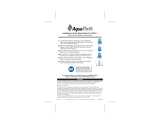
TABLEOF CONTENTS
REFRIGERATOR SAFETY ..........................................................3
ProperDisposalofYour Old Refrigerator....................................3
INSTALLING YOUR REFRIGERATOR .......................................4
Unpacking Your Refrigerator.......................................................4
Space Requirements....................................................................4
Electrical Requirements ............................................................... 5
Removing the Doors .................................................................... 5
Removing the Door Handles ........................................................ 6
Connecting the Refrigerator to a Water Source .......................... 7
Interior Water Filter Installation .................................................... 8
Water System Preparation ........................................................... 8
Base Grille .................................................................................... 8
Door Closing ................................................................................. 8
Understanding Sounds You May Hear ........................................ 9
USING YOUR REFRIGERATOR .................................................9
Ensuring Proper Air Circulation .................................................... 9
Setting the Controls ................................................................... 10
Adjusting Control Settings ......................................................... 10
REFRIGERATOR FEATURES ................................................... 11
Water and Ice Dispensers .......................................................... 11
Base Grille Water Filtration and Monitoring System ................. 12
Interior Water Filtration System ................................................. 13
Refrigerator Shelves ................................................................... 13
Lateral Adjustable Shelf ............................................................. 14
Flip-up Shelf ............................................................................... 14
Adjustable Flip-up Shelf ............................................................. 14
Dell Drawer ................................................................................. 14
Convertible Vegetable/Meat Drawer, Crisper and Covers ........15
Convertible Vegetable/Meat Drawer Temperature Control .......15
Crisper Humidity Control ........................................................... 15
Utility or Egg Bin......................................................................... 16
Wine or Can/Bottle Rack ........................................................... 16
FREEZER FEATURES .............................................................. 16
Ice Maker and Storage Bin/Bucket ............................................ 16
Freezer Shelf .............................................................................. 17
Freezer Basket ........................................................................... 17
DOOR FEATURES .................................................................... 18
Door Rails ................................................................................... 18
Door Bins .................................................................................... 18
Can Rack .................................................................................... 18
CARING FOR YOUR REFRIGERATOR ...................................18
Cleaning Your Refrigerator ......................................................... 18
Changing the Light Bulbs ........................................................... 19
Power Interruptions .................................................................... 20
Vacation and Moving Care ......................................................... 20
TROUBLESHOOTING ............................................................... 20
ASSISTANCE OR SERVICE ..................................................... 24
Accessories ................................................................................ 24
WARRANTY .............................................................................. 25
WATER FILTER CERTIFICATIONS ......................................... 26
PRODUCT DATA SHEETS ....................................................... 28
TABLEDESMATIERES
SECURITE DU REFRIGERATEUR ........................................... 30
Mise au rebut de votre vieux refrigerateur................................. 30
INSTALLATION DU RE_FRIGERATEUR ................................... 31
Deballage de votre [efrigerateu[ ................................................ 31
Espacement requis..................................................................... 31
Specifications (_lectriques .......................................................... 32
Enlevement des portes ............................................................... 32
Enlevement des poignees des portes ........................................ 33
Raccordement du rdrigerateur a une canalisation d'eau .........34
Systeme interieur de filtration d'eau .......................................... 35
Preparation du systeme d'eau ................................................... 35
Grille de la base .......................................................................... 36
Fermeture des portes ................................................................. 36
Les bruits de I'appareil que vous pouvez entendre ................... 36
UTILISATION DU RE_FRIGleRATEUR ....................................... 37
Pour s'assurer d'une circulation d'air appropri(_e ...................... 37
Reglage des commandes .......................................................... 37
Ajustement des reglages de controle ........................................ 38
CARACTERISTIQUES DU RleFRIGleRATEUR ......................... 38
Distributeurs d'eau et de glaqons .............................................. 38
Systeme de filtration et de controle d'eau a la
grille de la base ........................................................................... 40
Systeme de filtration d'eau interieur .......................................... 41
Tablettes du refrigerateur ........................................................... 41
Tablette reglable laterale ............................................................ 42
Tablette relevable ....................................................................... 42
Tablette relevable ajustable ....................................................... 42
Tiroir pour specialites alimentaires ............................................ 42
Tiroir a legumes/viande convertible, bac a
legumes et couvercles ............................................................... 43
Reglage de la temperature du tiroir
legumes/viande convertible ....................................................... 43
Reglage de I'humidite dans le bac a legumes ........................... 44
Casier utilitaire ou oeufrier .......................................................... 44
Casier a vin ou porte-cannettes/bouteilles ................................ 44
CARACTE_RISTIQUES DU CONGE_LATEUR ............................ 44
Machine a glacons et bac/seau d'entreposage ........................ 44
Tablette de congelateur ............................................................. 46
Partier de congelateur ................................................................ 46
CARACTE_RISTIQUES DE LA PORTE ...................................... 46
Tringles dans la porte ................................................................. 46
BaIconnets .................................................................................. 46
Porte-cannettes .......................................................................... 47
ENTRETIEN DE VOTRE RE_FRIGERATEUR ............................ 47
Nettoyage du [efrigerateu[ ......................................................... 47
Remplacement des ampoules d'eclairage ................................ 47
Pannes de courant ..................................................................... 48
Entretien avant les vacances ou lots d'un demenagement .......49
DI_PANNAGE .............................................................................49
ASSISTANCE OU SERVICE ......................................................53
Accessoires................................................................................53
GARANTIE .................................................................................54
FEUlLLES DE DONNEES SUR LE PRODUIT ..........................55




















